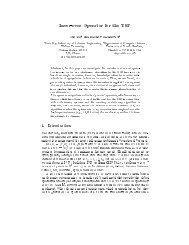A Parameterized Runtime Analysis of Evolutionary Algorithms for ...
A Parameterized Runtime Analysis of Evolutionary Algorithms for ...
A Parameterized Runtime Analysis of Evolutionary Algorithms for ...
You also want an ePaper? Increase the reach of your titles
YUMPU automatically turns print PDFs into web optimized ePapers that Google loves.
School <strong>of</strong> Computer Science, University <strong>of</strong> Adelaide<br />
A <strong>Parameterized</strong> <strong>Runtime</strong><br />
<strong>Analysis</strong> <strong>of</strong> <strong>Evolutionary</strong><br />
<strong>Algorithms</strong> <strong>for</strong> MAX-2-SAT<br />
Jareth Day, Andrew M. Sutton and Frank Neumann<br />
School <strong>of</strong> Computer Science<br />
University <strong>of</strong> Adelaide, Australia<br />
Genetic and <strong>Evolutionary</strong> Computational Conference<br />
July 2012<br />
Life Impact | The University <strong>of</strong> Adelaide
School <strong>of</strong> Computer Science, University <strong>of</strong> Adelaide<br />
Introduction<br />
• Introduce MAX-2-SAT and FPT<br />
• <strong>Parameterized</strong> complexity analysis on MAX-2-SAT<br />
• Identify fitness landscape <strong>of</strong> MAX-2-SAT<br />
• Produce parameterized algorithms <strong>for</strong> MAX-(2,3)-SAT.<br />
Life Impact | The University <strong>of</strong> Adelaide
School <strong>of</strong> Computer Science, University <strong>of</strong> Adelaide<br />
MAX-2-SAT<br />
• Maximum 2-Satisfiability Problem<br />
• C = {(l1,1 ∨ l1,2), (l2,1 ∨ l2,2), . . . , (lm,1 ∨ lm,2)}<br />
• eg C = {(¬v1 ∨ v2), (v1 ∨ v3), . . . , (v6 ∨ vn)}<br />
• m clauses, C i = {l 1 , ... , l m }<br />
• n Boolean variables v i = true/false<br />
Life Impact | The University <strong>of</strong> Adelaide
School <strong>of</strong> Computer Science, University <strong>of</strong> Adelaide<br />
MAX-2-SAT<br />
• C = {(¬v1 ∨ v2), (v1 ∨ v3), . . . , (v6 ∨ vn)}<br />
• Given x ∈ {0,1} n ,<br />
xi = 1 corresponds to vi = true,<br />
xi = 0 corresponds to vi = false<br />
• We want to maximize f : {0,1} n → {0} ∪ [m]<br />
• f(x) = number <strong>of</strong> clauses satisfied by x<br />
Life Impact | The University <strong>of</strong> Adelaide
School <strong>of</strong> Computer Science, University <strong>of</strong> Adelaide<br />
<strong>Parameterized</strong> Complexity<br />
• MAX-2-SAT is NP-Hard.<br />
• Standard algorithms: exp(|x|)<br />
• <strong>Parameterized</strong> complexity: parameterization K<br />
• XP algorithms: |x| g(K(x))<br />
eg n k<br />
• Fixed-parameter tractable (FPT) algorithms: g(K(x)) . |x| O(1)<br />
eg n . 2 k<br />
Life Impact | The University <strong>of</strong> Adelaide
School <strong>of</strong> Computer Science, University <strong>of</strong> Adelaide<br />
MAX-2-SAT Algorithm<br />
• We analyze the runtime <strong>of</strong> the (1+1) EA:<br />
• where mutate() negates some elements <strong>of</strong> x<br />
Life Impact | The University <strong>of</strong> Adelaide
School <strong>of</strong> Computer Science, University <strong>of</strong> Adelaide<br />
Uni<strong>for</strong>m-Complement Mutation<br />
• Traditional uni<strong>for</strong>m mutation creates <strong>of</strong>fspring by flipping<br />
each bit <strong>of</strong> x with probability 1/n<br />
• Uni<strong>for</strong>m-complement may, with uni<strong>for</strong>m probability,<br />
produce the complement <strong>of</strong> x with probability Θ(1).<br />
• Complement under uni<strong>for</strong>m mutation: probability O(n -n )<br />
Life Impact | The University <strong>of</strong> Adelaide
School <strong>of</strong> Computer Science, University <strong>of</strong> Adelaide<br />
Uni<strong>for</strong>m-Complement Mutation: Fitness Landscape<br />
• MAX-2-SAT fitness function and uni<strong>for</strong>m-complement<br />
operator corresponds to an elementary landscape.<br />
• Can reach solutions <strong>of</strong> certain quality in polynomial time by<br />
making local improvements.<br />
Life Impact | The University <strong>of</strong> Adelaide
School <strong>of</strong> Computer Science, University <strong>of</strong> Adelaide<br />
Uni<strong>for</strong>m-Complement Mutation: Fitness Landscape<br />
• Let N(x) be union <strong>of</strong> the Hamming neighbors <strong>of</strong> x and the<br />
complement <strong>of</strong> x<br />
• If the i-th clause is not satisfied by x, it is satisfied <strong>for</strong> three<br />
neighbors y ∈ N(x):<br />
• The two Hamming neighbors <strong>of</strong> x that have the variables<br />
in the i-th clause negated, and<br />
• The complement <strong>of</strong> x.<br />
• If the i-th clause is satisfied by x, at least one <strong>of</strong> its literals<br />
evaluates to true under x.<br />
• If only one true, clause is satisfied <strong>for</strong> all y ∈ N(x) except<br />
<strong>for</strong> the negation <strong>of</strong> variable involved in the true literal.<br />
• If both true, clause is satisfied <strong>for</strong> all y ∈ N(x) except <strong>for</strong><br />
the complement.<br />
Life Impact | The University <strong>of</strong> Adelaide
School <strong>of</strong> Computer Science, University <strong>of</strong> Adelaide<br />
Uni<strong>for</strong>m-Complement Mutation: Fitness Landscape<br />
€<br />
• If clause i unsatisfied by x, clause satisfied by three<br />
neighbors.<br />
• If clause i satisfied by x, clause satisfied by |N(x)| - 1<br />
neighbors.<br />
• Let c i : {0,1} n → {0,1} if clause i is satisfied by x.<br />
∑<br />
y∈N(x)<br />
c i<br />
(y) = 3(1 − c i<br />
(x)) + (| N(x) | −1)c i<br />
(x) = 3 + (n − 3)c i<br />
(x)<br />
• Since f(x) is the sum <strong>of</strong> the clauses satisfied in x<br />
∑<br />
y∈N(x)<br />
f (y) =<br />
m<br />
∑<br />
i=1<br />
(3+ (n − 3)c i<br />
(x))<br />
= 3m + (n − 3) f (x)<br />
Life Impact | The University <strong>of</strong> Adelaide<br />
€
School <strong>of</strong> Computer Science, University <strong>of</strong> Adelaide<br />
Uni<strong>for</strong>m-Complement Mutation: Fitness Landscape<br />
• Until no further improvements can be made, there are two<br />
cases in which an improvement is generated.<br />
• Complement is improving state.<br />
Probability ½ to choose.<br />
• Hamming neighbor is improving state.<br />
Probability ½(n -1 (1 - n -1 ) n-1 ) ≥ (2en) -1 = Ω(n -1 )<br />
• Number <strong>of</strong> improvements bounded by number <strong>of</strong> clauses.<br />
• Reaches state with no improvements in expected time<br />
bounded by O(mn)<br />
Life Impact | The University <strong>of</strong> Adelaide
School <strong>of</strong> Computer Science, University <strong>of</strong> Adelaide<br />
Uni<strong>for</strong>m-Complement Mutation: Fitness Landscape<br />
• Reached solution x’ s.t. f(x’) has best fitness in neighborhood<br />
• Current state x = x’<br />
€<br />
€<br />
€<br />
1<br />
| N(x') |<br />
1<br />
| N(x') |<br />
3m<br />
(n +1)<br />
∑<br />
y∈N(x )<br />
∑<br />
y∈N(x )<br />
+<br />
(n − 3)<br />
(n +1)<br />
f (x') ≥ 3 4 m<br />
f (y) ≤ f (x')<br />
(3m + (n − 3) f (x')) ≤ f (x')<br />
f (x') ≤ f (x')<br />
Life Impact | The University <strong>of</strong> Adelaide
School <strong>of</strong> Computer Science, University <strong>of</strong> Adelaide<br />
MAX-(2,3)-SAT<br />
• Restricted problem: MAX-(2,3)-SAT<br />
• Each variable may only appear in at most 3 clauses<br />
• eg C = {(¬v1 ∨ v2), (v1 ∨ ¬v3), (¬v1 ∨ ¬v5), . . .}<br />
• Still NP-hard<br />
Life Impact | The University <strong>of</strong> Adelaide
School <strong>of</strong> Computer Science, University <strong>of</strong> Adelaide<br />
MAX-(2,3)-SAT<br />
• Graph: G(V,E)<br />
|V| = n<br />
E = {{u,v} ⊂ V | u and v appear together in a clause}<br />
• As long as there are two variables in a clause, there’s an<br />
edge.<br />
• Diameter <strong>of</strong> G: maximum shortest-path distance in any <strong>of</strong><br />
the connected components<br />
• Parameter: diameter <strong>of</strong> G is bounded by k<br />
Life Impact | The University <strong>of</strong> Adelaide
School <strong>of</strong> Computer Science, University <strong>of</strong> Adelaide<br />
MAX-(2,3)-SAT<br />
• C(v) is a connected component containing node v<br />
• With diameter bounded by k, the number <strong>of</strong> nodes in C(v) is<br />
bound by:<br />
k -1<br />
∑<br />
1+ 3 ⋅ 2 i<br />
i=0<br />
= 3 ⋅ 2 k - 2 ≥ C(v)<br />
€<br />
Life Impact | The University <strong>of</strong> Adelaide
School <strong>of</strong> Computer Science, University <strong>of</strong> Adelaide<br />
Basic FPT Algorithm<br />
• Select v i uni<strong>for</strong>mly at random.<br />
• Flip all bits in x associated with Boolean variables in C(v i )<br />
with probability 1/2<br />
Life Impact | The University <strong>of</strong> Adelaide
School <strong>of</strong> Computer Science, University <strong>of</strong> Adelaide<br />
Modified FPT Algorithm<br />
• Select vi uni<strong>for</strong>mly at random.<br />
• Flip all bits in x associated with Boolean variables in C(vi) with<br />
decreasing probability the further the distance from vi<br />
Life Impact | The University <strong>of</strong> Adelaide
School <strong>of</strong> Computer Science, University <strong>of</strong> Adelaide<br />
Propagation FPT Algorithm<br />
• Select vi uni<strong>for</strong>mly at random.<br />
• Flip all bits in x associated with Boolean variables in C(vi) with<br />
decreasing probability the further the distance from vi. Only<br />
propagates to next bit if current bit flipped.<br />
Life Impact | The University <strong>of</strong> Adelaide
School <strong>of</strong> Computer Science, University <strong>of</strong> Adelaide<br />
Modified Propagation FPT Algorithm<br />
• Select vi uni<strong>for</strong>mly at random.<br />
• Flip all bits in x associated with Boolean variables in C(vi) with<br />
decreasing probability the further the distance from vi. Only<br />
propagates to next bit if current bit flipped. Only visits bits at<br />
increasing distance from vi.<br />
Life Impact | The University <strong>of</strong> Adelaide
School <strong>of</strong> Computer Science, University <strong>of</strong> Adelaide<br />
Expected Time to Completion<br />
• Number <strong>of</strong> nodes in connected component bound by<br />
g(k)= 3 . 2 k - 2<br />
XP (in paper) O(n g(k) )<br />
Simple FPT O(n log n . 2 g(k) )<br />
Modified FPT O(n log n . 2 k .g(k)<br />
)<br />
Propagation FPT O(n log n . 2 g(k)2 )<br />
Modified Propagation FPT O(n log n . 2 k .g(k)<br />
)<br />
Life Impact | The University <strong>of</strong> Adelaide
School <strong>of</strong> Computer Science, University <strong>of</strong> Adelaide<br />
Conclusion<br />
• We analyzed MAX-2-SAT and MAX-(2,3)-SAT and determined:<br />
• Elementary landscape <strong>of</strong> MAX-2-SAT<br />
• XP evolutionary algorithm <strong>for</strong> MAX-(2,3)-SAT<br />
• FPT evolutionary algorithms <strong>for</strong> MAX-(2,3)-SAT<br />
Life Impact | The University <strong>of</strong> Adelaide


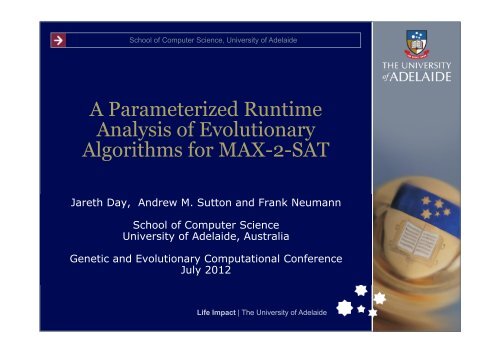

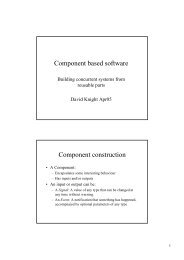
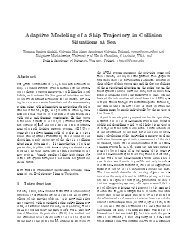
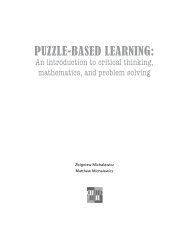
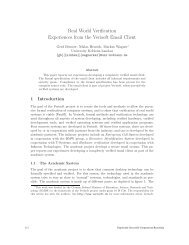


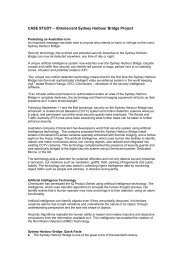
![Final Draft Thesis [pdf] - School of Computer Science](https://img.yumpu.com/30448543/1/184x260/final-draft-thesis-pdf-school-of-computer-science.jpg?quality=85)

